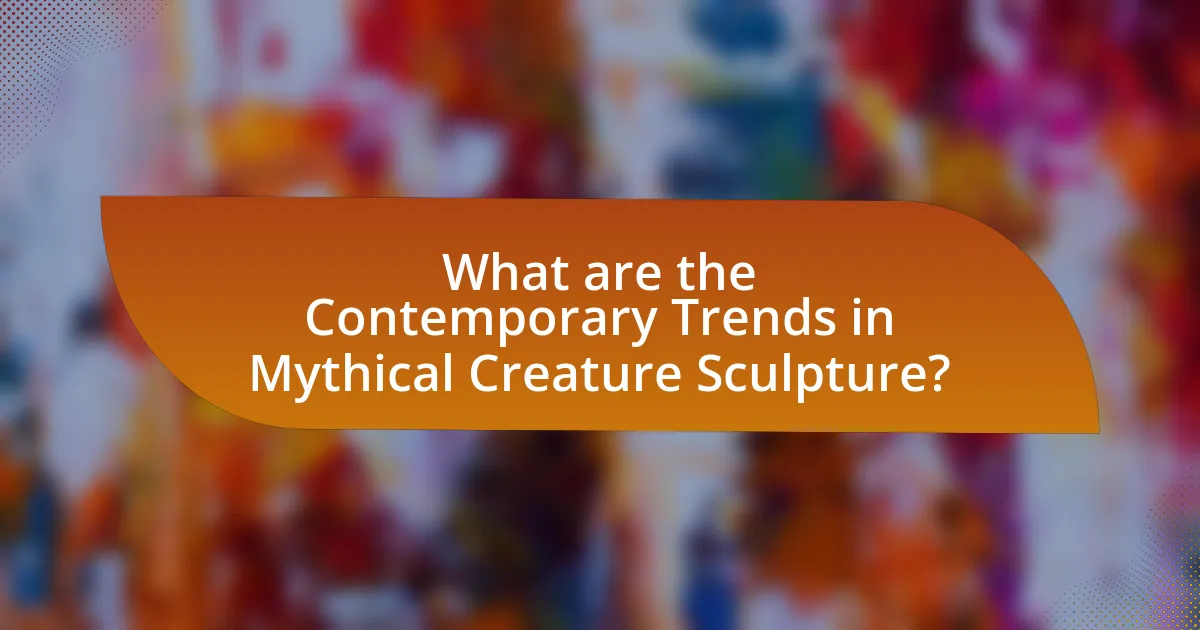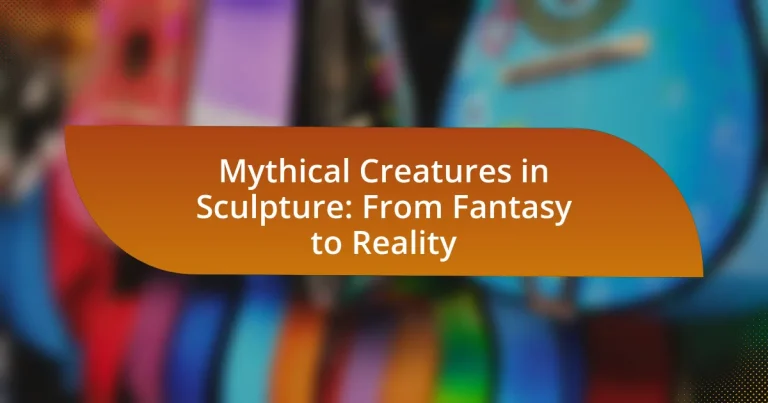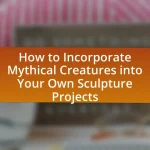Mythical creatures in sculpture are artistic representations derived from folklore, mythology, and fantasy, embodying traits of both animals and humans. This article explores the historical influence of mythical creatures on sculpture, highlighting notable examples from ancient civilizations and how different cultures interpret these beings. It examines the themes represented by mythical creatures, their role in enhancing narratives, and the techniques sculptors use to bring them to life. Additionally, contemporary trends in mythical creature sculpture are discussed, including the use of modern materials and the reinterpretation of traditional themes by contemporary artists. The article also provides practical tips for aspiring sculptors interested in creating their own mythical beings.

What are Mythical Creatures in Sculpture?
Mythical creatures in sculpture are artistic representations of beings that originate from folklore, mythology, and fantasy, often embodying traits of various animals and humans. These sculptures serve as a medium to explore cultural narratives and beliefs, with examples including griffins, dragons, and mermaids, which have been depicted in various historical contexts, such as ancient Greek and Roman art. The presence of mythical creatures in sculpture reflects humanity’s fascination with the supernatural and the symbolic meanings attributed to these beings, as seen in works from different cultures, such as the Chinese dragon symbolizing power and strength or the Greek sphinx representing mystery and protection.
How have mythical creatures influenced sculpture throughout history?
Mythical creatures have significantly influenced sculpture throughout history by serving as symbols of cultural beliefs, artistic expression, and storytelling. For instance, ancient civilizations like the Greeks and Romans created sculptures of creatures such as centaurs and griffins, which represented the merging of human and animal traits, reflecting their understanding of nature and the divine. In the Middle Ages, sculptures of dragons and unicorns were prevalent, often symbolizing good versus evil and the quest for purity, as seen in Gothic cathedrals. The Renaissance period saw a revival of classical themes, with artists like Michelangelo incorporating mythical figures into their works, emphasizing humanism and the exploration of the human condition. This historical trajectory illustrates how mythical creatures have not only enriched the aesthetic value of sculpture but also conveyed deeper philosophical and cultural narratives across different eras.
What are some notable examples of mythical creatures in ancient sculptures?
Notable examples of mythical creatures in ancient sculptures include the griffin, centaur, and sphinx. The griffin, a creature with the body of a lion and the head and wings of an eagle, is prominently featured in ancient Persian and Greek art, symbolizing strength and protection. Centaurs, depicted as half-human and half-horse beings, are prevalent in Greek mythology and are often represented in classical sculptures, illustrating the duality of human nature. The sphinx, with a lion’s body and a human head, is a significant figure in Egyptian art, particularly in the Great Sphinx of Giza, which embodies wisdom and mystery. These sculptures not only reflect the artistic styles of their respective cultures but also convey the values and beliefs associated with these mythical beings.
How did different cultures interpret mythical creatures in their sculptures?
Different cultures interpreted mythical creatures in their sculptures by reflecting their unique beliefs, values, and environmental contexts. For instance, ancient Greek sculptures often depicted creatures like centaurs and griffins, symbolizing the duality of human nature and the connection between the divine and the earthly. In contrast, Mesopotamian art featured lamassu, hybrid beings with human heads and animal bodies, representing protection and strength, often placed at city gates to ward off evil. Similarly, in Asian cultures, dragons are revered as symbols of power and good fortune, leading to their intricate representations in Chinese sculptures, which emphasize fluidity and grace. These interpretations reveal how each culture utilized mythical creatures to convey moral lessons, societal ideals, and spiritual beliefs, thus embedding their cultural narratives into the art form.
Why do artists choose to depict mythical creatures in their work?
Artists choose to depict mythical creatures in their work to explore themes of imagination, cultural symbolism, and the human experience. By incorporating these fantastical beings, artists can transcend the limitations of reality, allowing for the expression of complex ideas and emotions that resonate across different cultures and time periods. For instance, mythical creatures often embody societal values, fears, or aspirations, as seen in ancient mythologies where gods and monsters reflect human traits and moral lessons. This artistic choice not only captivates audiences but also invites them to engage with deeper philosophical questions, making the artwork more impactful and thought-provoking.
What themes do mythical creatures represent in sculpture?
Mythical creatures in sculpture represent themes such as the duality of nature, the struggle between good and evil, and the exploration of human emotions. These themes are often depicted through the characteristics and narratives associated with the creatures, such as dragons symbolizing power and chaos, or unicorns representing purity and grace. Historical examples include the use of griffins in ancient art to signify strength and protection, and mermaids in Renaissance sculptures reflecting the allure and danger of the unknown. These representations serve to convey complex ideas about humanity’s relationship with the supernatural and the moral lessons derived from these mythological beings.
How do mythical creatures enhance the narrative of a sculpture?
Mythical creatures enhance the narrative of a sculpture by introducing elements of fantasy and symbolism that deepen the viewer’s engagement. These creatures often embody cultural myths, moral lessons, or human emotions, allowing sculptures to convey complex stories and themes. For instance, sculptures featuring dragons may symbolize power and protection, while those depicting unicorns can represent purity and grace. The incorporation of these creatures invites viewers to explore the underlying narratives, connecting them to broader cultural contexts and historical significance, such as the use of griffins in ancient art to signify strength and vigilance. This narrative enhancement not only enriches the aesthetic experience but also fosters a deeper understanding of the cultural and historical narratives that the sculptures represent.

How do Mythical Creatures Bridge Fantasy and Reality in Sculpture?
Mythical creatures bridge fantasy and reality in sculpture by embodying imaginative concepts while utilizing tangible materials and techniques. Sculptors often draw inspiration from folklore, mythology, and cultural narratives, translating these fantastical beings into physical forms that can be experienced in the real world. For instance, the use of bronze or marble allows artists to create detailed representations of creatures like dragons or griffins, which exist only in the realm of imagination. This fusion of the fantastical with the physical is evident in historical works, such as the ancient Greek sculptures of centaurs, which reflect both artistic skill and the cultural significance of these mythological figures. By materializing these creatures, sculptures invite viewers to engage with the stories and symbolism behind them, effectively bridging the gap between the imagined and the real.
What techniques do sculptors use to bring mythical creatures to life?
Sculptors use techniques such as modeling, carving, and casting to bring mythical creatures to life. Modeling involves shaping materials like clay or wax to create detailed forms, allowing for intricate features that capture the essence of mythical beings. Carving, on the other hand, entails removing material from a solid block, often stone or wood, to reveal the creature’s shape, emphasizing texture and detail. Casting involves pouring liquid material, such as bronze or resin, into a mold to create a durable representation of the creature. These methods enable sculptors to translate imaginative concepts into tangible art, as seen in historical works like Michelangelo’s “David” or contemporary pieces that explore fantasy themes.
How does material choice affect the representation of mythical creatures?
Material choice significantly influences the representation of mythical creatures by affecting their texture, color, and overall aesthetic appeal. For instance, sculptors often use materials like marble or bronze to convey a sense of permanence and grandeur, which aligns with the fantastical nature of these beings. In contrast, materials such as clay or wood may evoke a more organic and approachable representation, emphasizing the mythical creature’s connection to nature. Historical examples include the use of bronze in ancient Greek sculptures, which allowed for intricate details and a sense of movement, enhancing the viewer’s perception of the mythical figures. Thus, the selected material not only shapes the visual characteristics of the creature but also impacts the emotional response it elicits from the audience.
What role does scale play in the perception of mythical creatures in sculpture?
Scale significantly influences the perception of mythical creatures in sculpture by altering their visual impact and emotional resonance. Larger sculptures often evoke awe and grandeur, enhancing the mythical status of the creature, while smaller sculptures can create intimacy and personal connection. For instance, the colossal statue of a griffin can dominate a space, emphasizing its power and majesty, whereas a miniature dragon might invite closer inspection and personal interpretation. This relationship between scale and perception is supported by studies in art psychology, which indicate that size affects viewer engagement and emotional response, reinforcing the mythical qualities attributed to these creatures.
In what ways do mythical creatures challenge our understanding of reality?
Mythical creatures challenge our understanding of reality by blurring the lines between the possible and the impossible. These beings, such as dragons and unicorns, exist in folklore and art, prompting individuals to question the nature of existence and the limits of human imagination. Historical accounts, like those from ancient civilizations that depicted griffins in their art, illustrate how these creatures were often used to explain natural phenomena or convey moral lessons, thus influencing cultural beliefs and perceptions of reality. The persistence of mythical creatures in modern storytelling and art continues to inspire discussions about the boundaries of reality, imagination, and belief systems.
How do mythical creatures reflect societal beliefs and values?
Mythical creatures reflect societal beliefs and values by embodying the fears, aspirations, and moral lessons of the cultures that create them. For instance, dragons often symbolize power and chaos in various cultures, representing the struggle between good and evil, as seen in European folklore where they are frequently depicted as adversaries to be conquered by heroes. In contrast, in Asian cultures, dragons are revered as symbols of wisdom and benevolence, reflecting values of harmony and prosperity. Additionally, creatures like mermaids can illustrate societal views on femininity and the unknown, often representing both allure and danger, which mirrors cultural attitudes towards women and nature. Historical texts, such as “Beowulf,” showcase how these creatures serve as metaphors for societal challenges, reinforcing the idea that mythical beings are not just fantasy but are deeply intertwined with the moral and ethical frameworks of their respective societies.
What psychological effects do mythical creatures in sculpture have on viewers?
Mythical creatures in sculpture evoke a range of psychological effects on viewers, including fascination, fear, and a sense of wonder. These sculptures often trigger emotional responses due to their fantastical nature, which can stimulate the imagination and encourage viewers to explore themes of mythology and fantasy. Research indicates that exposure to mythical imagery can enhance creativity and inspire storytelling, as seen in studies that link visual art to cognitive engagement. Additionally, the presence of mythical creatures can elicit feelings of nostalgia or cultural connection, as they often represent shared narratives within specific communities. This multifaceted psychological impact underscores the significance of mythical creatures in art as a means of exploring human emotions and cultural identity.

What are the Contemporary Trends in Mythical Creature Sculpture?
Contemporary trends in mythical creature sculpture include a focus on hybrid forms, sustainability, and interactive installations. Artists are increasingly blending various mythical elements to create unique, imaginative creatures that challenge traditional representations. Additionally, there is a growing emphasis on using eco-friendly materials and techniques, reflecting a broader societal concern for environmental sustainability. Interactive installations are also becoming popular, allowing viewers to engage with the sculptures in immersive ways, enhancing the experience of mythical narratives. These trends are evident in exhibitions and art fairs, where innovative approaches to mythical themes are showcased, demonstrating the evolving nature of this artistic genre.
How are modern artists reinterpreting mythical creatures in their work?
Modern artists are reinterpreting mythical creatures by blending traditional symbolism with contemporary themes and materials. For instance, artists like Takashi Murakami incorporate elements of Japanese folklore into vibrant, pop-art styles, creating a dialogue between ancient myths and modern consumer culture. Additionally, sculptors such as Kiki Smith utilize organic materials and forms to explore themes of femininity and nature, reimagining creatures like mermaids and centaurs as reflections of current societal issues. This approach not only revitalizes the narrative of mythical beings but also makes them relevant to today’s audience, demonstrating how ancient stories can evolve through modern artistic expression.
What new materials and technologies are being used in contemporary sculptures?
Contemporary sculptures increasingly utilize materials such as 3D-printed plastics, metal composites, and bio-based materials. These innovations allow artists to create intricate designs and structures that were previously unattainable. For instance, 3D printing technology enables the production of complex forms with precision, while metal composites provide durability and a modern aesthetic. Additionally, bio-based materials, derived from renewable resources, reflect a growing trend towards sustainability in art. This shift in materials and technologies not only enhances artistic expression but also aligns with contemporary values of environmental consciousness and innovation.
How do contemporary sculptures of mythical creatures differ from traditional ones?
Contemporary sculptures of mythical creatures differ from traditional ones primarily in their use of modern materials and techniques, as well as their thematic exploration. Traditional sculptures often utilized stone, bronze, or wood, focusing on classical representations and mythological narratives, while contemporary artists frequently incorporate materials like resin, metal, and mixed media, allowing for innovative forms and textures. Additionally, contemporary works often challenge or reinterpret mythological themes, reflecting current societal issues or personal experiences, whereas traditional sculptures typically adhered to established mythological stories and aesthetics. This shift is evident in the works of artists like Damien Hirst and Takashi Murakami, who blend pop culture with mythological elements, showcasing a departure from the rigid conventions of earlier art forms.
What are some prominent contemporary artists known for their work with mythical creatures?
Prominent contemporary artists known for their work with mythical creatures include Takashi Murakami, who often incorporates elements of Japanese folklore and fantastical beings into his vibrant artworks. Another notable artist is Kiki Smith, recognized for her sculptures that explore themes of mythology and the human-animal connection, often featuring hybrid creatures. Additionally, the work of Damien Hirst frequently includes motifs of mythical beings, particularly in his exploration of life and death through fantastical imagery. These artists exemplify the integration of mythical themes in contemporary art, reflecting cultural narratives and personal interpretations of legendary creatures.
What influences shape the work of these contemporary artists?
Contemporary artists working with mythical creatures in sculpture are shaped by influences such as cultural mythology, personal experiences, and societal issues. Cultural mythology provides a rich source of inspiration, as artists draw from ancient stories and symbols to create modern interpretations of mythical beings. Personal experiences, including emotional journeys and identity exploration, inform the themes and narratives within their work. Additionally, societal issues, such as environmental concerns and the impact of technology, influence how these artists portray mythical creatures, often reflecting contemporary anxieties and aspirations. These influences collectively contribute to a dynamic dialogue between fantasy and reality in their sculptures.
How do these artists engage with audiences through their sculptures?
Artists engage with audiences through their sculptures by creating immersive experiences that evoke emotional responses and provoke thought. For instance, sculptures of mythical creatures often incorporate intricate details and dynamic forms that invite viewers to explore the narratives behind these figures, fostering a connection between the artwork and the audience. Additionally, interactive elements, such as augmented reality features or participatory installations, enhance engagement by allowing audiences to experience the sculptures in a personal and meaningful way. This approach is supported by studies showing that interactive art can significantly increase viewer involvement and emotional investment, thereby deepening the overall impact of the artwork.
What practical tips can aspiring sculptors consider when creating mythical creatures?
Aspiring sculptors creating mythical creatures should focus on thorough research and conceptualization. Understanding the mythology and characteristics of the creature enhances authenticity and creativity. For instance, studying various depictions of dragons across cultures can inform design choices, such as scale texture and body structure. Additionally, sketching multiple designs before sculpting allows for exploration of different forms and features, ensuring a well-rounded final piece. Using reference materials, such as photographs of animals or existing sculptures, can provide insight into anatomy and movement, which is crucial for creating believable mythical forms.


